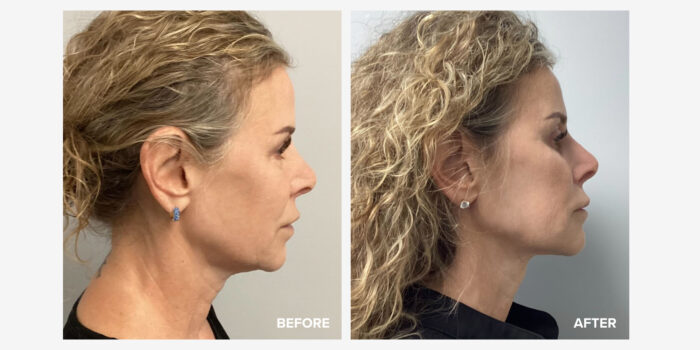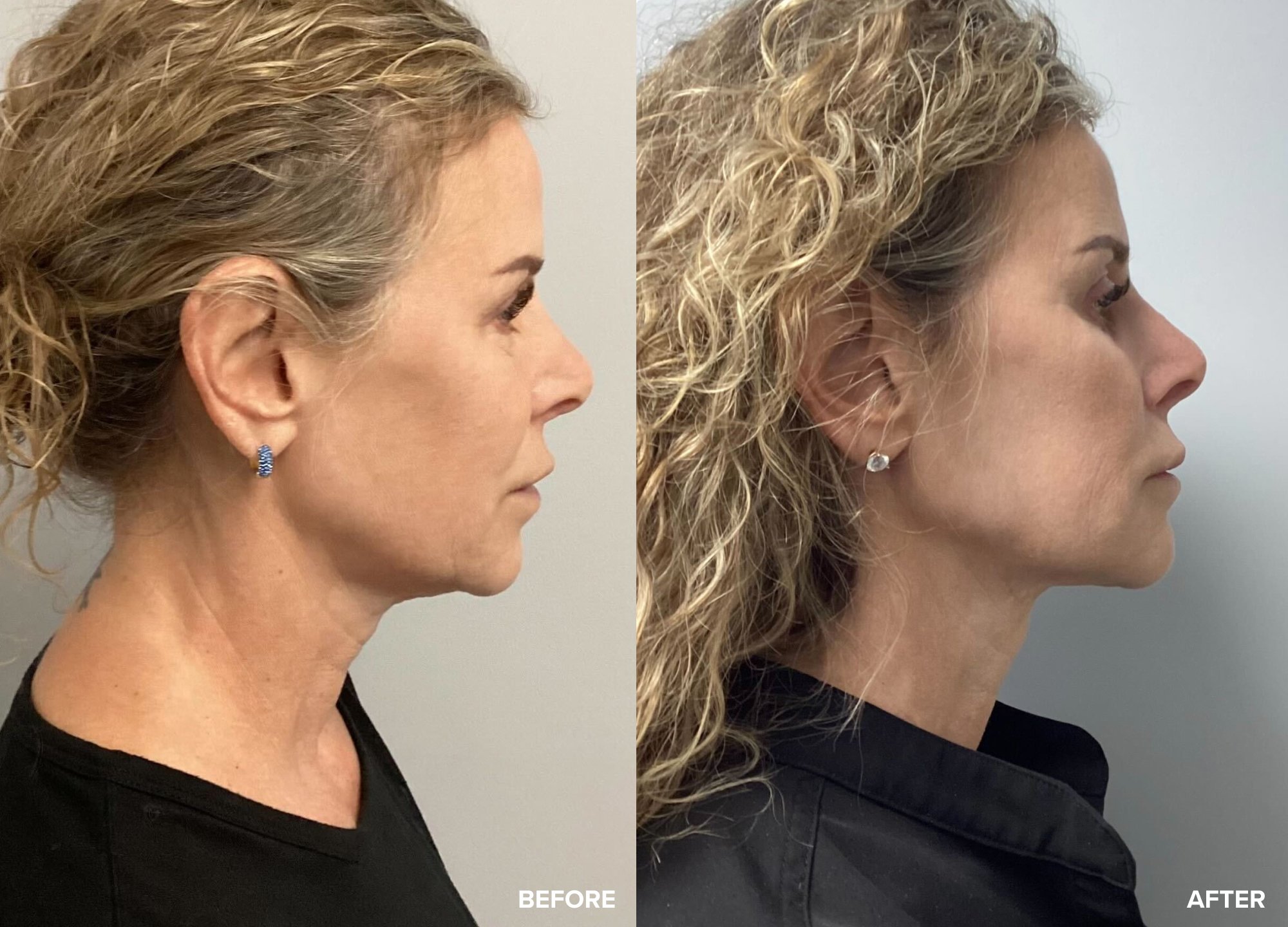Christina is a woman living in New York City. After having multiple consultations for a facelift and neck lift, she decided to try a more minimally invasive procedure, due to wanting to minimize risk, scarring, and downtime. This is her story, as told to Carolyn Hsu and edited for length and clarity.
The treatment I tried
I got FaceTite, liposuction, and MyEllevate, to lift my jowls and tighten my jawline without undergoing a facelift or neck lift.
My provider
Dr. Andrew Peredo, a board-certified plastic surgeon in New York City and on Long Island
What is FaceTite?
FaceTite is a minimally invasive skin-tightening procedure that uses radiofrequency technology and is primarily done around the lower face, to sculpt and tighten the neck and jawline. It is part of the Morpheus8 “family,” using the same machine but a different handpiece. Another handpiece called AccuTite is used for skin tightening around the eyes and brows. FaceTite works by delivering targeted radiofrequency energy to the facial tissue layers using a probe, which is inserted under the skin and moved back and forth over the treatment area. The probe heats the skin and stimulates collagen production, resulting in skin contraction and a tighter, more youthful appearance.
FaceTite also melts fat, which helps to enhance the cosmetic result. Because of this, Dr. Peredo says that FaceTite should always be performed with liposuction, “even if the liposuction is at an absolute minimum. The melted fat is a big irritant and should be sucked out, to lessen the inflammatory response.”
The biggest safety concerns are contour deformities, burns, and temporary nerve damage that can cause the lower lip to drop, says Dr. Peredo. All of these complications can be minimized by going to an experienced board-certified plastic surgeon.
Who is an ideal candidate for FaceTite?
According to Dr. Peredo, the ideal candidate is someone who doesn’t want a surgical facelift and has mild skin laxity that can’t be effectively treated with other nonsurgical modalities. “These ‘gap’ patients have some aging but not enough skin excess to warrant a surgical facelift,” he says. “Patients with mild to moderate skin laxity are the best candidates for FaceTite, while those with moderate to severe skin laxity may still benefit from it but won’t get full correction with radiofrequency alone. FaceTite’s lifting power isn’t as strong as a surgical facelift, but it is stronger than that of fillers and other energy tightening devices,” he says, while noting that for some patients, FaceTite alone may not be powerful enough to achieve desired results but can be combined with other procedures for more dramatic transformations. Which leads us to…
What is MyEllevate, and who is a good candidate?
MyEllevate is a nonsurgical thread that is specifically used for jawline contouring. The thread is inserted through eight tiny incision points using a light-guided rod, and it physically lifts and suspends the neck like a hammock using a permanent suture, supporting the skin and tissue. “I recommend MyEllevate for patients who have mild to moderate skin laxity of the neck, especially the central neck,” says Dr. Peredo. “MyEllevate is different from the popular threads on social media. This permanent suture happens to be the same material/suture that I, and many other plastic surgeons, use to tighten the neck muscles in an open surgical neck lift.” Results can be expected to last for five years, at which point the procedure can be repeated.
Why I tried FaceTite and MyEllevate
I’ll be turning 54 this year. I’ve tried almost every nonsurgical treatment out there. I have done a laser a month for about a year. I have also done Silhouette InstaLift for my jawline. I had that done twice in my 40s, which did help, but at a certain age, it no longer gives the same results. I also got fillers in my jawline when I was 51 and 52; they helped but didn’t give the results I was looking for.
What intrigued me about FaceTite was the simplicity of having an in-office procedure without having to go under general anesthesia or needing stitches to achieve the results I wanted. I was looking to tighten up the skin on my neck and jawline and lift the jowl area slightly.
In addition to FaceTite, I had liposuction, Morpheus8, and MyEllevate. The whole four-part procedure, from walking into the office to leaving, took about two hours and 20 minutes. Dr. Peredo took my pictures, numbed me with an injection, and prepped me for the procedure. He made sure I was comfortable and couldn’t feel any pain before starting. The procedure felt like pressure, similar to being numb at the dentist when they have to pull a tooth or fill a cavity. Dr. Peredo started with filling my submental area and along the jawline with tumescent fluid, which is the local anesthesia. The first injection to numb the area was a bit of a pinch, but once the fluid was in, I felt only a little pressure without any discomfort. Throughout the procedure, I was talking to Dr. Peredo, and I took just half a Valium as an anxiety medication.
The first step of the procedure was FaceTite, where a probe was inserted just under the skin of my jawline and chin to tighten from the inside out. It took about 20 minutes. Next, Dr. Peredo did liposuction in the jowl area, to see if there was any fat that he could extract. After that, he performed Morpheus8 on my lower face, from my cheek area to my jawline. The reason for doing Morpheus8 before MyEllevate is that you can’t have microneedling in the area where MyEllevate is applied.
MyEllevate is a permanent suture, guided by a light that shows the exact depth it needs to reach in your skin. There are eight little holes made, but you really can’t see them much after three weeks. During the procedure, Dr. Peredo broke up the platysmal bands with a tool that looked like a long needle. He then went in and inserted MyEllevate, and I could feel the tightening effect when he pulled the suture.
After the procedure, I was numb and didn’t need any painkillers, just some Tylenol. The first night was a bit uncomfortable because I had to sleep elevated with my head wrapped,wearing a neck brace. But after the initial 24 hours, there was only some tightness and no significant pain. As for swelling, it was moderate for the first 48 hours.
I had to keep my head bandage on 24 hours a day for three days, and I was able to shower on the third day. I had to be cautious when showering, to avoid getting the area wet. Wearing the dressing felt compressive and a bit itchy at times, which is normal during the healing process. After a week of wearing the bandage 24 hours a day, I followed Dr. Peredo’s advice and continued to wear it every night for two weeks, to ensure the best possible result. I also wore a neck brace for two weeks, to prevent looking down at my phone or computer, which could cause the bands to reattach incorrectly and create rippling that is hard to get rid of.
For post-procedure skin care, I used Alastin Regenerating Skin Nectar to treat the area where I had microneedling done and on my incision points. The nectar was originally created for burn victims, and I found that it helped speed up my skin’s recovery.
I did experience some bruising, which was located at the base of my neck and extended into my chest area. The bruising appeared as some yellowing, but overall, there was less swelling and bruising than I had anticipated. The MyEllevante procedure caused some tightness, making me more cautious when turning my neck from side to side during the first week.
My FaceTite results


At just two and a half weeks out, the combination of FaceTite, Morpheus8 and MyEllevate far exceeded the results of fillers, Silhouette InstaLift, and microneedling. I saw results immediately after the procedure when the staff took my picture. At the two-week mark, I noticed my jawline was significantly tighter, and I couldn’t even grab the excess skin that I used to play with. The treated area, especially on the front of my neck, has shown significant improvement, and the best part is, I don’t believe there are any visible signs of the procedure.
Dr. Peredo said I was the perfect candidate for this type of procedure due to the laxity of the skin, the amount I needed lifted at my jawline, my age, and my overall health. I’ve had consultations for a lower facelift and neck lift, which would have involved physically excising skin and leaving behind scars. However, this procedure tightens the skin with heat, and there’s no cutting, pulling, or tacking up of the skin, which can lead to skin puckering. As I continue to age, I may need to come back for more FaceTite, but for now, I’m extremely pleased with the results.











